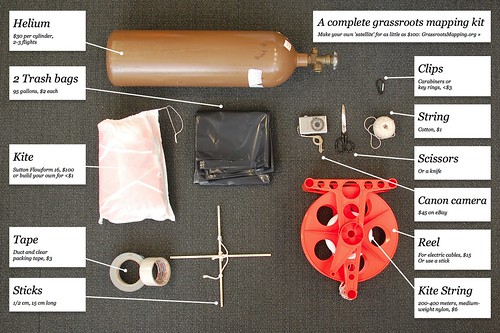Balloon Mapping Materials
These lists will help you buy the materials you need to get started
Pick and choose from the basic or advanced kits, and read in more detail about specific choices below. Also see the Illustrated Guide for a downloadable PDF with a simplified set including assembly and use instructions.
Helium
For any kit you're going to need helium, so that's a good first place to start.
- In the US, helium costs ~180 dollars for a large 240 cubic foot tank, or ~60 dollars for an 80 cubic foot tank. 80 cubic feet should get you 2 flights with a 4-5 foot diameter balloon, enough to lift a camera. For mylar balloons it may only last one flight, but if you seal them well, you should be able to keep the balloons inflated in a safe place for reuse for several days.
- Measure how much helium you'll need to lift your camera with this handy table.
Beginner/low-cost materials list
- one balloon balloonsdirect.com
- 35 dollars for a 5.5-foot balloon, or 24 dollars for 4-foot if your camera is light
- Two or three $1.50 mylar emergency sleeping bags (more durable and cheaper, and retain helium better if inflated for more than a few hours. See discussion, but they must be taped shut and sealed very well to work.
- 1 two-liter plastic soda bottle (rounded, not conic neck works best, see the Soda Bottle Rig page)
- at least 1000 feet braided nylon string, like kite string, mason line, anything strong and very light. You can tie two 500' spools together into a 1000' line.
- duct tape & clear packing tape
- a cheap digital camera with Continuous mode shooting. (where you can just hold down the button and it takes repeated pictures), and a rubber band to pin down the button. The Canon A490 is a good one, though it does not work with the CHDK.
- helium to fill the balloon to about a 5-foot diameter

Advanced/high performance materials list
- $12 Ball-bearing compact kite reel or a simpler 10" Yo-Yo style reel, which is less likely to damage your line, but takes longer to reel in.
- $20 3000 foot 50 pound kite line (there's sometimes a deal for $10 pink reels, but dark colors probably show up less in photos)
- ~$3 metallized mylar sleeping bags -- you'll need 2 or 3 per flight; get the ones that already have yellow taped seams, and you just have to tape up the opening. If you properly fold over and tape this last seam, and check the other corners for leaks, it should stay inflated for several days.
- 1" wide Gaffer tape is lovely -- it sticks and resticks many times, and is very strong.
- a Picavet suspension may stabilize your camera, some people still prefer the Soda Bottle Rig
- a Canon camera and the CHDK hacked firmware to trigger the camera at longer intervals (check compatibility on the CHDK website). This can save battery and memory for longer flights.
- If you're going to be doing a lot of this, consider buying an aluminum helium tank, which you can keep as long as you like, and which is much easier to carry: 280 dollars for 125 cu feet (~2 flights) or 180 dollars for 55 cu feet (~1 flight).
Notes and discussion of materials
String
Your most basic option is the medium weight nylon, or mason line (#18, rated to ~150 lbs) from a hardware store. It's often sold in 500 foot rolls for a few dollars. Buy 2 or 3 and put them on a reel, like this $4 cord reel -- you really want 1000-1500 feet minimum.
For much higher flights, ~4000+ feet, you want lighter and stronger string. Monofilament fishing line (the clear kind) is risky because it can suddenly snap. Braided spectra gets worn and will also snap unexpectedly. This may be because fishing line (esp. high strength) is designed to be used in the open ocean without obstacles to get caught on or tangled in. But if you're careful it has very low drag and we've used it for some great flights on days with almost no wind.
We've found that the best choice is Dacron, which is what kite flyers use. It's not quite as thin and strong as fishing line, but we can buy 3000 feet at 50 pound strength for only $20 here:
http://www.kitebuilder.com/catalog/index.php/cPath/30_192 (there's sometimes a deal for $10 pink reels)
Cameras
These days, you can just go for the cheapest -- you can get a 10mp camera for $55 or so. Just make sure the camera has a continuous shooting mode where you can hold down the button to trigger continuous photos every second or so.
I've been using the Canon A490, which is great, for around $60-80. It takes AA batteries which is nice in a pinch. Most recent Canons have continuous shooting -- just be sure to put it in P or M mode.
Some grassroots mappers finesse manual settings based on how cloudy it is, etc, but I've had a few flights where the sun broke free of the cloud cover and overexposed my photos.
So I tend to leave everything on auto -- full resolution, S quality (super, or minimal compression).
If you can turn off the LCD it'll save battery but then it's hard to confirm that it's actually continuously shooting. It's unclear if leaving the "click" sound on saves battery vs. using the LCD, but with AA batteries it really hasn't been a problem... you run out of memory first.
